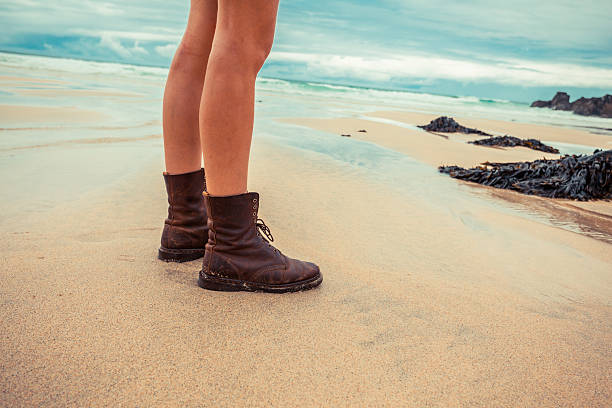Introduction
Ever felt like your feet were trapped in a pair of stiff, uncomfortable shoes? You’re not alone. Traditional shoes can often restrict your foot’s Movement, leading to discomfort and long-term issues. Enter barefoot shoes—an innovative footwear option that promises to give your feet the freedom they deserve. In this guide, we’ll explore what barefoot shoes are, their benefits, how to choose the right pair and much more. By the end of this article, you’ll have all the information you need to make an informed decision about going barefoot—at least in your shoes!
What Are Barefoot Shoes?
Barefoot shoes are designed to mimic your feet’ natural shape and Movement. Unlike traditional shoes, which often have thick soles and arch support, barefoot shoes have minimal cushioning and a wide toe box, allowing your toes to spread out naturally. The idea behind barefoot shoes is simple: they let your feet function as they were meant to, without unnecessary interference.
Why Choose Barefoot Shoes?
- Improved Foot Health
- Wearing can Barefoot Shoes strengthen feet and improve posture. The minimalist design encourages the muscles in your feet to work harder, which can lead to increased strength over time. This can help prevent common foot problems like plantar fasciitis and bunions.
- Natural Movement
- Barefoot shoes promote a more natural walking and running gait. Because they lack the thick soles and elevated heels of traditional shoes, they encourage a midfoot or forefoot strike rather than a heel strike. This can reduce the impact on your joints and lead to a more efficient stride.
- Better Balance and Proprioception
- With less material between your foot and the ground, barefoot shoes enhance your proprioception—your body’s ability to sense its position in space. This can improve balance and coordination, which are crucial for athletic performance and everyday activities.
- Environmental and Ethical Considerations
- Many barefoot shoe companies focus on sustainability, using eco-friendly materials and ethical manufacturing practices. By choosing barefoot shoes, you can also make a more environmentally conscious decision.
How to Choose the Right Barefoot Shoes
- Consider Your Foot Shape
- Everyone’s feet are different, so it’s crucial to choose a pair of barefoot shoes that match the shape of your foot. Look for a shoe with a wide toe box and a sole that matches the natural curve of your foot.
- Think About the Terrain
- Where do you plan to wear your barefoot shoes? If you’re running on rough trails, you’ll want a pair with a bit more protection. A thinner sole might be more comfortable for everyday use on smooth surfaces.
- Start Slow
- Transitioning to barefoot shoes can take time, mainly if you’re used to traditional Footwear. Start by wearing your barefoot shoes for short periods and gradually increase the time as your feet adjust.
Competitor Analysis
To ensure this blog post stands out, let’s examine three competitor articles closely and identify where we can provide more detailed and helpful information.
- Vivobarefoot Blog
- The Vivobarefoot blog offers a broad overview of the benefits of barefoot shoes, focusing heavily on their product line. While informative, it lacks depth in explaining how to choose barefoot shoes and the transition process.
- Xero Shoes Blog
- Xero Shoes’ blog is rich with personal stories and testimonials, which adds a human touch. However, it could benefit from more scientific explanations and a broader discussion of the benefits beyond just anecdotal evidence.
- Merrell Blog
- Merrell’s blog does an excellent job of explaining the technical aspects of barefoot shoes but falls short in offering practical tips for beginners. It also lacks a thorough discussion on the environmental benefits of barefoot shoes.
New Information and Detailed Insights
- The Science Behind Barefoot Shoes
- Unlike competitors, we’ll explore the science behind barefoot shoes. Research has shown that wearing barefoot shoes can strengthen the foot’s intrinsic muscles. A study published in the Journal of Foot and Ankle Research found that minimalist Footwear can increase foot muscle size and strength, potentially reducing injury risk.
- Transitioning Safely
- While many blogs briefly mention the need for a gradual transition, we’ll provide a detailed, step-by-step guide on how to make the switch safely. This will include specific exercises to strengthen your feet and a timeline for gradually increasing wear time.
- A Broader Environmental Perspective
- We’ll expand on the environmental benefits of barefoot shoes and discuss the importance of sustainable materials like recycled rubber and organic cotton. We’ll also highlight brands that prioritize ethical manufacturing practices, offering readers options that align with their values.
How to Transition to Barefoot Shoes
Switching to barefoot shoes isn’t as simple as tossing out your old sneakers and lacing up a new pair. Your feet have likely grown accustomed to the support and cushioning of traditional shoes, so you’ll need to take it slow.
- Start with Short Walks
- Begin by wearing barefoot shoes for short walks around your house or neighbourhood. This will give your feet time to adjust to the new feeling without overwhelming them.
- Incorporate Foot Exercises
- Strengthen your feet with exercises like toe curls, arch lifts, and calf raises. These exercises will help prepare your muscles for the demands of barefoot walking and running.
- Gradually Increase Wear Time
- Over a few weeks, gradually increase the amount of time you spend in your barefoot shoes. Pay attention to how your feet feel and back off if you experience discomfort.
- Listen to Your Body
- Transitioning too quickly can lead to discomfort or injury. If you feel pain, take a break and give your feet time to recover before trying again.
Frequently Asked Questions About Barefoot Shoes

- Are barefoot shoes suitable for everyone?
- While barefoot shoes can benefit many people, they may only suit some. If you have specific foot conditions or a history of foot injuries, it’s best to consult a healthcare professional before making the switch.
- Can I run in barefoot shoes?
- Yes, many people successfully run in barefoot shoes. However, to avoid injury, it’s important to start slow and gradually build up your distance.
- Do barefoot shoes strengthen your feet?
- Yes, studies have shown that wearing barefoot shoes can increase the strength of the muscles in your feet, particularly the intrinsic muscles often neglected in traditional Footwear.
- Are there any downsides to barefoot shoes?
- The main downside is the need for a gradual transition. You risk overloading your feet and causing discomfort or injury without proper preparation. Additionally, barefoot shoes offer less protection from sharp objects, so you must be mindful of where you step.
Conclusion
Barefoot shoes offer a compelling alternative to traditional Footwear, promoting natural Movement, better balance, and improved foot health. By choosing the right pair and transitioning gradually, you can enjoy the many benefits of barefoot shoes. Whether you want to strengthen your feet, improve your posture, or simply feel more connected to the ground, barefoot shoes might be the perfect fit. Now that you’re armed with all this information, why not give them a try and experience the difference for yourself?





